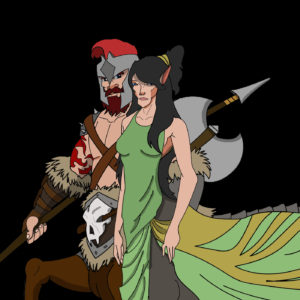Centaur (sehn-tawr)
Centaurs were part of the three “taurs,” a separate group of intelligent halfbreeds deemed to be different than traditional people. They bred similar to humans. They were not monogamous by nature. Males had at least three mates and sired no less than seven young foals throughout their lifetime. Young centaurs of either sex that were one year or younger were called “foals,” ages one to two found them progressing to the “yearling” stage, males aged 8 – 13 years old were “colts,” females were “fillies,” adult males were “stallions,” and adult females were “mares.”
Lifestyle
Centaurs were scattered throughout Fabella. Because any habitat had to accommodate their large half stallion bodies, centaur structures were quite a bit bigger than traditional shelters.
Centaurs normally stayed together in their own communities throughout history. “Stalla (Stah-lah),” located in Euplar, was the only country in the world ever exclusively inhabited by the centaur race. As populations in cities across the world grew during the Expansion Age, centaur tribes were continually pushed out of their regions and into Stalla. Buildings in Stalla were big, wide, and tall with a set of ramps and later elevators in place of stairs.
Anatomy
Both horse and human internal organs made up a centaur. It took a long time for food to pass through their bodies because it had to pass through two stomachs and two colons before it even reached the rectum. In fact, centaurs had two sets of every single organ. This enabled them to run for much longer distances than any other animal because they had four working lungs. Another thing they had four of was legs. In the early years of Fabella, transportation was non-existent. Hunting depended on how far a creature could go on their own legs while carrying a fresh carcass. Centaurs could go further, run faster, and carry more weight than any other person on Fabella.

